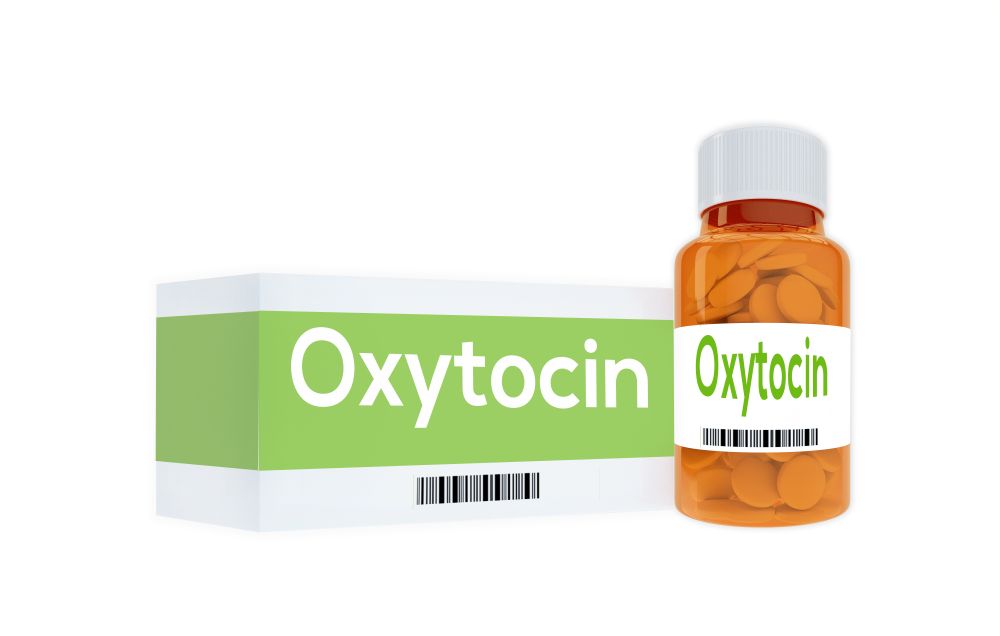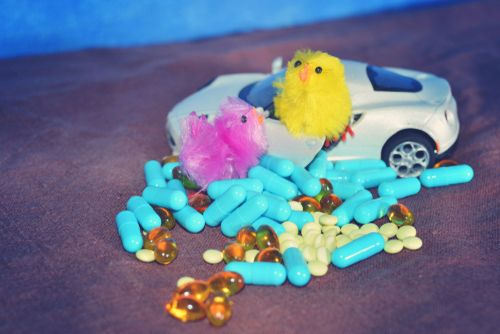
D Sharon Pruitt | Source: Wikimedia Commons
Love Pill:
Oxytocin or Emotional Labor?
Is there a chemical shortcut for producing social change? Writer Elvia Wilk unpacks the cultural assumptions behind scientific research on the bonding hormone oxytocin and its potential pharmaceutical applications. Based on this research, some proponents want to extrapolate the modification of individual hormonal states to broader social improvements—a central theme in Wilk's forthcoming speculative fiction, titled Oval.
1.
Oxytocin is a hormone manufactured by the hypothalamus and stashed in the pituitary gland. Popularly known as the “bonding hormone,” it kicks in upon physical contact—sexual or platonic—elevating feelings of intimacy, emotional connection, and affection. It floods the female body in great amounts during childbirth, regulating contractions, prompting lactation, and eventually helping stimulate an affective response in the mother. Even the thought of cuddling or the mere sight of cuteness can prompt an oxytocin response.
This is the hormone that makes your heart melt when you see kittens, puppies and human babies,
says Irina Conboy, a University of California, Berkeley researcher who studies oxytocin’s effects.
As with any chemical, much surrounding research is driven by the hormone’s potential pharmaceutical applications. For instance, Conboy has studied its promising effects on muscle regeneration and aging. In a study she and other researchers conducted in 2014, injections of oxytocin were proven to help regenerate damaged muscle tissue in geriatric mice, halting or even reversing the aging process.Christian Elabd et al., “Oxytocin Is an Age-Specific Circulating Hormone That Is Necessary for Muscle Maintenance and Regeneration,” Nature Communications, vol. 5 (2014): https://www.ncbi.nlm.nih.gov/pmc/articles/PMC4512838. In the United States, oxytocin has become the first “anti-aging molecule” approved for clinical use. It’s also been the subject of studies applying it to a range of ailments, including fibromyalgia, chronic pain, and alcoholism. However, currently its clinical uses remain rare for anything but its common application as an injection to help speed up labor.
Ailments aside, artificially inducing the hormone’s psychological “cuddle effect” is an alluring but more difficult task. The main obstacle is that injections and pills can get oxytocin only into the circulatory and digestive systems, not into the brain. Oxytocin is a peptide that can’t typically cross the blood-brain barrier, the membrane that keeps the brain insulated from pathogens (and assumedly most human test subjects are unwilling to have a hormone injected into their skulls). But through repeated animal trials, researchers have shown that it’s possible to get a small but temporarily effective amount of oxytocin into the brain through nasal inhalation, where gaps in the blood-brain barrier exist.
Enter oxytocin nasal spray—a research subject that has quickly entered the realm of pop psychology and pseudoscience. While many research outcomes about nasal inhalation are ambivalent or inconclusive, conjuring more questions than answers, the notion that a quick huff could induce emotional attachment is just too alluring a prospect for many to resist. The consumer target group for such a product is exceedingly wide: desperate lovers, the families of children with mood disorders seeking evidence of affection, do-gooders looking for ways we could all just get along.
Given a widespread societal “there’s an app for that” mentality, the fantasy that there could be “a spray for that”—compassion, empathy, attachment—plays into a whole host of beliefs and desires. The most obvious such desire is simply instant gratification as an end in itself, as opposed to attending to the complex sociocultural and interpersonal factors that make up relationships, much less the very hard work maintaining relationships can demand. But this impulse also glosses over the distinction between feeling and acting. What’s the correlation between emotional state and outward behavior? Does an outpouring of affection make up for lazy or bad relationship skills? If what you desire is to feel loved, does it matter why someone treats you with affection?

large
align-left
align-right
delete
2.
A foremost proponent of the incredible benefits of oxytocin is Dr. Paul Zak, a professor at California’s Claremont Graduate University who calls himself a “neuroeconomist” interested in how economic decisions relate to neurological factors. This amounts to an evolutionary psychology approach whereby affective states are believed to be hardwired into the brain and body. For Zak, those hardwired psychological traits affect not only individuals’ lives but the way entire populations function. In one 2011 TED Talk viewed over 1.5 million times, Zak gives this explanation of how the psychological factor of “trustworthiness” correlates to wide-scale economic disparity:
I had shown in the early 2000s that countries with a higher proportion of trustworthy people are more prosperous. So in these countries, more economic transactions occur and more wealth is created, alleviating poverty. So poor countries are by and large low-trust countries. So if I understood the chemistry of trustworthiness, I might help alleviate poverty.Paul Zak, “Trust, Morality—and Oxytocin?,” Ted Talk, video, 16:28, July 2011, https://www.ted.com/talks/paul_zak_trust_morality_and_oxytocin?language=en.
The dodgy cause-and-effect conclusions Zak makes between psychological traits and economic outcomes are extrapolated from his interest in molecules like oxytocin and their supposedly straightforward effects. He refers to himself periodically as “Dr. Love,” rhapsodizing about how hormone production bonds couples, forges friendships, and enhances empathy. From the same TED Talk:
Dr. Love says, eight hugs a day—you’ll be happier and the world will be a better place. Of course,
he adds, brandishing a tiny vial of oxytocin on stage,
if you don’t like to touch people, I can always shove this up your nose.
Zak’s might sound like a some retro free-love attitude, if it weren’t for the chemical vial in his hand.
Zak’s outlook is also telling because of how it cuts across scales. Attributes like empathy and trust, he suggests, are not only physically instantiated, but reproducible and scalable. If your body isn’t producing enough oxytocin to make you act empathetic toward your spouse, or enough of whatever hormone he supposes makes you more trustworthy and therefore more prosperous, you can just add these hormones to your system (and, by extension, should). Moral goodness has a biological basis, and therefore it can be engineered—maybe even scaled up by infusion into the water supply. And how else to measure goodness on the scale of the nation-state but in terms of GDP?
You’ll be happier, and the world will be a better place.
Click here to insert text for the typewriter
This morality-inducibility-scalability trifecta neatly accords with the common neoliberal worldview that puts the onus on individuals’ affects and behaviors to solve (heal?) global inequality rather than, say, governments or corporations. The manipulation of affect in late-stage capitalism occurs most obviously through advertising campaigns, but as Zak suggests, it can also be done with chemical alteration—drugs. (This is not a stretch: consider the fact that over a third of US Americans are currently taking prescription medications.Carolyn Y. Johnson, "More than a third of American adults take prescription drugs linked to depression, study says," Washington Post, June 12, 2018, https://www.washingtonpost.com/gdpr-consent/?destination=%2fnews%2fwonk%2fwp%2f2018%2f06%2f12%2fmore-than-a-third-of-american-adults-take-prescription-drugs-that-may-increase-risk-of-depression-study-says%2f%3f&utm_term=.ad762f3fe58b)
The hope is that whatever induces subjects to feel more emotion will make them better people, will make them more generous, will make them spend and donate more. Changing society becomes a matter of simply managing consumer behavior. Of course, this functional view of emotion reduces compassion to a lever to pull for spare change, which is a rather dire prospect for the real free-lovers among us. In accordance with the classic philanthropic model, rather than holding those holding the majority of economic power to account, Zak would shovel moral responsibility onto the individual. And it doesn’t matter whether the individual desire to take on this responsibility is voluntary.
3.
In response to the refugee influx in Europe in 2015, Nicholas Kristof wrote in his New York Times column that Westerners need to learn to empathize more with the suffering others whose photographs were circulating online.
If you don’t see yourself or your family members in those images of today’s refugees,
he writes,
you need an empathy transplant.Nicholas Kristof, “Refugees Who Could Be Us,” New York Times, September 6, 2015, https://www.nytimes.com/2015/09/06/opinion/sunday/nicholas-kristof-refugees-who-could-be-us.html.
The hypothetical empathy transplant (nasal spray?) recurs constantly in liberal discourse. Global suffering is caused by a lack of empathy: if only we could just trigger it. And in the United States at least, the empathy divide has formed the substructure for much bipartisan political rhetoric—the left continues to plead for more love, less hate. More empathy for refugees; more graphic depictions of the violence to prompt said empathy. This makes the counterargument on the right simple: Empathy is latitude, softness, weakness, femininity. The inability to make the hard (tough-guy) choices based on the cold facts.
Empathy, like all brain-body phenomena, is not defined by a single neurochemical impulse, nor is it traceable to one stimulus. And empathy presents a particularly difficult case study, because the internal “felt” state of empathic response does not correlate directly with its hoped-for external expression, which is often called altruism. In other words, if what you want to provoke is the outward expression of kindness or generosity, trying to induce an empathetic state through oxytocin may not be the best choice. Many years of research demonstrate that oxytocin doesn’t operate indiscriminately or consistently to produce the “good” behavior someone like Zak might expect.
Although oxytocin is sometimes nicknamed the “moral molecule,” psychologist Carsten de Dreu explains that oxytocin
doesn’t make people more moral or immoral. It shifts people’s focus from themselves to their group or tribe.Ed Yong, “Oxytocin Boosts Dishonesty,” Scientist, March 31, 2014, https://www.the-scientist.com/news-opinion/oxytocin-boosts-dishonesty-37740.
In one 2014 study titled “Oxytocin Promotes Group-Serving Dishonesty,” de Dreu and his collaborators gave sixty volunteers either oxytocin spray or a placebo spray.Shaul Shalvi and Carsten K. W. de Dreu, “Oxytocin Promotes Group-Serving Dishonesty,” Proceedings of the National Academy of Sciences of the United States of America, vol. 111, no. 15 (April 14, 2014): https://www.pnas.org/content/111/15/5503. They were then given an exercise that asked them to predict the result of a coin toss. The winning earnings from correct guesses were in some cases shared among small groups and in other cases the winners were allowed to keep the entire amount for themselves. The subjects who had been given oxytocin tended to be more honest about the correctness of their guesses when only their own money was at stake, but were more likely to lie about how they’d guessed if it would benefit their whole team. That is, extra oxytocin does not make one categorically more honest; it makes one want to bond with one’s in-group.
These findings highlight the role of bonding and cooperation in shaping dishonesty, providing insight into when and why collaboration turns into corruption,
write the study authors.Shalvi and de Dreu, “Oxytocin Promotes Group-Serving Dishonesty.”

large
align-left
align-right
delete
Further studies suggest that oxytocin triggers specific behaviors according to preexisting associations and relationships. While on oxytocin, “socially secure” subjects were more likely to remember their mothers as kind and caring, whereas insecure or anxious subjects remembered their mothers more negatively.Jennifer A. Bartz et al., “Effects of Oxytocin on Recollections of Maternal Care and Closeness,” Proceedings of the National Academy of Sciences of the United States of America, vol. 107, no. 50 (December 14, 2010): https://www.pnas.org/content/107/50/21371. See also J. Bartz et al., “Oxytocin Can Hinder Trust and Cooperation in Borderline Personality Disorder,” Social Cognitive and Affective Neuroscience, vol. 6, no. 5 (2011): https://www.ncbi.nlm.nih.gov/pubmed/21115541. Another study reported that oxytocin increased instances of “intimate partner violence” when given to subjects predisposed to aggressive behavior.C. Nathan DeWall et al., “When the Love Hormone Leads to Violence: Oxytocin Increases Intimate Partner Violence Inclinations among High Trait Aggressive People,” Social Psychological and Personality Science, vol. 5, no. 6 (February 12, 2014): https://doi.org/10.1177/1948550613516876. Yet another suggests that oxytocin intake can strengthen out-group bias to the extent that ethnocentrist attitudes are displayed.Carsten K. W. de Dreu et al., “Oxytocin Promotes Human Ethnocentrism,” Proceedings of the National Academy of Sciences of the United States of America, vol. 108, no. 4 (January 25, 2011): https://www.pnas.org/content/108/4/1262. One theory that supports many of the above findings is that oxytocin might simply heighten awareness to voluntary and involuntary social cues, so that the reactions of others are amplified in the subject’s mind, whether they are positive or negative.S. Leknes, “Oxytocin Enhances Pupil Dilation and Sensitivity to ‘Hidden’ Emotional Expressions,” Social Cognitive and Affective Neuroscience, vol. 8, no. 7 (October 2013): https://www.ncbi.nlm.nih.gov/pubmed/22648957. Amplification of perceived emotional states could engender a feeling of oneness and togetherness, but could just as easily contribute to an us-versus-them or me-versus-you mentality if others are perceived as threatening.
4.
Following so many disheartening studies, the titles of think pieces on oxytocin have noticeably changed in recent years. From “Brain in Love” and “‘Cuddle Chemical’ May Boost Male Empathy” before, Google now turns up “The Two Faces of Oxytocin” and “Shining Light on the Dark Side of Oxytocin.” But the fearmongering headlines don’t fundamentally diverge from the miracle-cure ones. Oxytocin may now have “two faces,” but it’s still presented as responsible for automatic biological reactions. In fact, the proposition that oxytocin has a “sinister” side reinforces the notion that humans are helpless to the workings of our chemical compositions. That would mean that whether we like it or not, individual responses are somehow baked in. It follows that, to fix those responses, the best recourse would be chemical or biological intervention. Moral goodness is a biological trait; anyone missing it needs an “empathy transplant.” Why engage in education when there’s a nasal spray for that?

large
align-left
align-right
delete
If emotions and behaviors are baked in, it’s easy to write off socially contrived differences as biological ones. Herein lies the classic potential pitfall of evolutionary biology. The gendered aspects of the structure of much oxytocin research demonstrates this problem clearly. Oxytocin, associated with childbirth, love and family relationships, and emotional reactiveness, is undoubtedly associated with the female body; studies reinforce its feminine associations, and those aspects of life thus remain the natural purview of the feminine. If there were any doubt as to how social constructs like gender are reproduced by this kind of thinking, Dr. Zak designed an experiment that demonstrates the logic. In 2010, he attended a wedding to conduct this experiment, in which he drew blood from the wedding party and guests before and after the ceremony to assess the hormonal changes. He describes his findings in the Wall Street Journal:
The changes in individual oxytocin levels at Linda’s ceremony could be mapped out like the solar system, with the bride as the sun. Between the first and second draws of blood, which were only an hour apart, Linda’s own level shot up by 28%. For the other people tested, the increase in oxytocin was in direct proportion to the likely intensity of their emotional engagement in the event. The mother of the bride? Up 24%. The father of the groom? Up 19%. The groom himself? Up 13% … and on down the line. But why, you may ask, would the groom’s increase be less than his father’s? Testosterone is one of several other hormones that can interfere with the release of oxytocin, and the groom’s testosterone level, according to our blood test, had surged 100%! As the guests admired Linda in her strapless bridal gown, he was the alpha male.
In this odd constellation, Linda, the bride, radiates female emotions after achieving monogamous hetero coupledom, alongside her nameless groom, whose aggressive maleness is evidenced by his testo state having increased twofold now that he’s fully dominated and domesticated his partner. One could spend a lot of time analyzing this imagined scene—especially factoring in the narrator, a vampiric psychologist standing beside the pew with tourniquets and syringes—but suffice it to say that Zak’s belief that feeling more is what will make us better people and the world a better place does not apply in the same way to everyone. Some people are supposed to feel more of certain things. For instance, in this scenario, women are supposed to feel more sentimental and affectionate, and men are supposed to feel more “alpha.” This suggests that, since women are oxytocin prone, empathy is more “natural to them,” and the burden of exercising empathy and turning it into altruism—a.k.a. emotional labor—will continually fall to them.
Seeing empathy as a natural response skips over the question of labor altogether. If some people have less oxytocin receptors than others, should they be excused from doing the hard work of emotional identification that produces meaningful social bonds and care relations? Should they be dosed with excess hormones? Or could people simply learn through a lot of time and effort how to form those bonds anyway? On the other hand—if they were made to learn, whose job would it be to teach them?
Some parts of this text were previously published in the essay “Science Fiction into Science Action,” Berlin Quarterly, no. 4 (Spring 2019). Previous research from the essay “Trauma Machine,” Popula, July 2018.